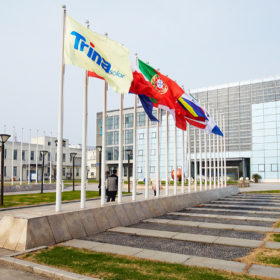Trina claims 3% energy gain with new tracking system over traditional trackers
The company’s integrated tracker manufacturer Nclave developed a new system designed primarily for large-form factor modules and with a new algorithm that promises to boost yield in diffuse light conditions.
Tesla launches solar inverter
The EV manufacturer with big solar ambitions has finally leveraged its expertise in power electronics technology and launched a solar inverter.
Metal producer disconnects solar plant from grid, trial started in Ukraine
Kyiv’s Commercial Court has begun hearing a case that could be of interest to solar developers with a stake in Ukraine’s solar sector, or those looking to buy into the country’s energy market. For nearly a year the grid connection of a solar plant had been capped by an adjacent metal producer. The legal proceedings could prove a test for Ukraine’s suitality to provide sufficient investor protection, the plaintiff stated ahead of the trial.
Peeking into 2021: Green bonds to reach US$500 billion per year, solar on track to outrank oil and gas
Global management consulting firm PricewaterhouseCoopers has issued a general economic prediction for 2021. Aside from some general notes on GDP recovery post-Covid, the analysts’ notes were heavily focussed on climate and energy finance and policy.
EU-China Comprehensive Agreement on Investment opens manufacturing options, dodges forced-labor issues
The European Commission has finalized its long-anticipated investment agreement with China. While some renewable energy businesses might benefit from improved investment security, IP protection and access to legal remedies in China, the Commission did not address the issue of Uyghur forced labor in China. As a majority block in the European Parliament had previously demanded from the Commisison to develop a firm policy to end forced labor in China, there is reason for doubt that the agreement as it stands will be adopted by the EU Parliament.
Irish ESB to add 100 MWh of Fluence storage to its portfolio
State-owned utility ESB is working with energy storage solution company Fluence and EPC service providers Powercomm Group and Kirby Group on its first battery projects in Ireland.
‘Europe’s battery recycling quotas are blunt and a decade too late’
Last week, the European Commission announced it plans to implement sustainability standards for Europe’s growing battery industry. Consultant Circular Energy Storage published a report on lithium-ion battery life cycle and recycling economics this month and its findings ask tough questions of the commission’s proposals.
DNV GL’s Battery Scorecard 2020 sees manufacturers focus on LFP and fire safety
The third annual scorecard published by the consultant has tested 22 batteries with different chemistries for cycling stability and temperature-dependent behaviour and identified significant product trends.
UK installs 5 MW ultracapacitor as ‘sonar’ to detect power grid inertia
Electricity system operator National Grid is planning for a fully decarbonized power network in five years. Following a power outage last year, the operator has taken a pioneering role in finding solutions to the issues of running a grid using only power-electronics-interfaced resources. One key aspect of grid stability, inertia, can be detected using an ultracapacitor.
A silver-oxide zinc battery — flexible, screen-printed and with 20 times the capacity of Li-ion
A team comprising researchers from the University of California San Diego and micro battery developer ZPower have developed been busy in the lab. The result is a flexible battery with highly competitive electrochemical features and the option to manufacture at low cost with screen-printing.











